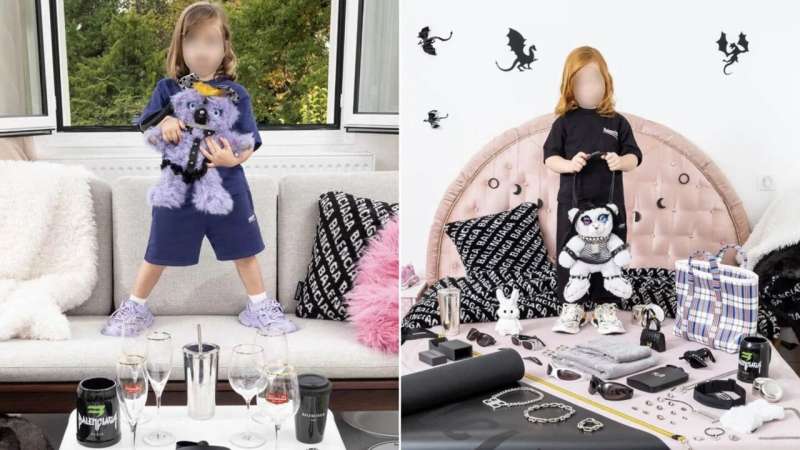
Credit: Balenciaga
Kim Kardashian is refining her personal brand. Right-wing news channel Fox TV is winning viewers through attention-grabbing headlines. The photographer Gabriele Galimberti is gaining notoriety. This is all due to a recent ad campaign by world leading fashion brand Balenciaga that has caused a lot of controversy.
One photograph shows a boy in a string vest holding a teddy bear dressed in bondage gear. Another shows a bag resting on child abuse papers. Balenciaga responded to the backlash to his campaign by issuing an apology in which he blamed set designers and photographers for the awkward messages. He also filed a US$25 million lawsuit against the campaign’s producers.
As a branding expert who has worked in advertising for more than 25 years, I am wary of Balenciaga’s answers. All major brands have staff in charge of approving this type of advertising campaign. The approval process would be especially thorough for a brand like Balenciaga, which spends around $100 million a year on advertising.
Advertising is, of course, designed to attract attention. According to the University of Southern California, urban consumers see more than 5,000 advertising messages a day, but remember only three or four. Brands invest a lot of money with the goal of becoming one of those memorable advertisements.
One technique used to achieve that goal is “shock advertising,” an ad that “deliberately, rather than inadvertently, shocks and offends its audience by violating norms of social values and personal ideals.” Fashion brands such as Benetton, Calvin Klein and FCUK have created impactful advertisements that have resulted in free media coverage benefiting the brand and those associated with it.
A story of successful fashion advertising
From the 1970s to the early 2000s, the Italian clothing brand Benetton created simple photo ads that featured controversial issues. A priest and a nun kissing. A black woman breastfeeding a white baby. A man dying of AIDS surrounded by his family.
These advertisements, placed in popular magazines and billboards, were designed to attract attention. The images of the dying man, for example, were published when it became known that AIDS had become the leading cause of death among young men in the US. The creator of the campaign, Oliviero Toscani, became world famous and Benetton an even more popular global brand, although it later broke ties with the photographer.
In the early 2000s, French Connection launched a campaign around the acronym FCUK (French Connection United Kingdom). His catchphrase “FCUKinkyBugger” prompted Britain’s advertising watchdog, the Advertising Standards Authority (ASA), to respond to 132 complaints from the public. French Connection reacted by placing the “Sorry FCUK” sign in their shop windows, attracting more young consumers to their high street stalls and increasing sales from £6.4m to £19m.
Brooke Shields reflects on her controversial Calvin Klein campaign.
In 1980, Calvin Klein ran ads featuring the teeny-finger supermodel Brooke Shields modeling the brand’s jeans while saying, “You know what comes between me and my Calvins? Nothing.”
Print and television ads placed the 15-year-old in sexually provocative positions and caused quite a stir among the public. In the US, the ABC network stations banned the TV commercial. However, due to the controversy, Calvin Klein boosted sales and Brooke Shields’ career took off. Since then, she has appeared on more than 300 magazine covers internationally and has starred in Hollywood movies.
Who benefits from shock advertising?
As these examples demonstrate, people associated with an impactful advertising campaign can take advantage of the news it generates to further their own interests.
Kardashian, who has been something of a muse for Balenciaga in recent years, posted a reaction on her Instagram to the controversial campaign. This allowed his fanbase to express his views on the matter, an example of Kardashian using the controversy to build his personal brand.
Galimberti, who photographed some of the most controversial images of Balenciaga’s campaign, stated: “I had no right in any way to… choose the products, nor the models, nor the combination thereof.” Since then, he has given several interviews to the mainstream media, bringing his name to an even larger audience and, potentially, the opportunity to gain new clients.
Balenciaga did not respond to our request for comment on whether the campaign may have intentionally courted press coverage. However, the brand’s creative director, Demna Gvasalia, released a public statement on December 2 taking personal responsibility for the campaign.
“As much as I would sometimes like to provoke thought through my work, I would NEVER intend to do so with a subject as horrible as child abuse which I condemn,” she told her Instagram followers. “It was inappropriate for children to promote items that had nothing to do with them.”
Shocking advertising strategies allow ads to be seen by millions of potential consumers even though they only run for a limited time before being removed. As the current controversy over Balenciaga demonstrates, the way to make paid advertising work more is to get it talked about for free.
Provided by The Conversation
This article is republished from The Conversation under a Creative Commons license. Read the original article.![]()
Citation: The fashion brand’s controversial new campaign and long history of ‘shockvertising’ (December 5, 2022) Retrieved December 13, 2022 from https://phys.org/news/2022-12-fashion-brand -controversial-campaign-history.html
This document is subject to copyright. Apart from any fair dealing for private study or research purposes, no part may be reproduced without written permission. The content is provided for informational purposes only.
Source: news.google.com